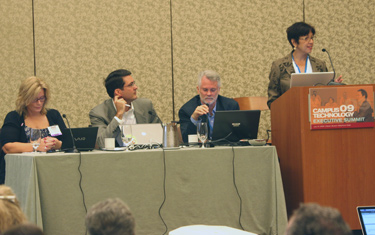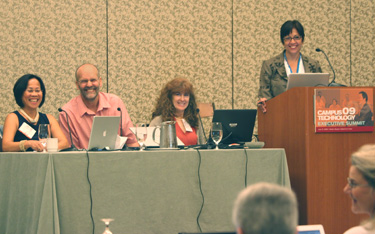Viewpoint
IT Leaders: Take a Deep Breath and Look Around You
Part 1 of a two-part commentary on the Campus Technology 2009 Executive Summit
At Campus Technology’s annual conference in Boston, July 27-30, 2009, an Executive Summit was held on the first day, during the pre-conference. The summit featured three discussion sessions made up of distinguished panelists moderated by Joan Getman of Cornell University, plus an afternoon workshop led by Chris Dede of Harvard.
The daylong summit of higher education technology leaders included reflections on the current state of higher education’s adaptation to information technology. Remarkable was the lack of the usual buzz about exciting technologies “that will change everything.” No one was ready to make any grand claims about technologies and how powerful they are. Instead, the group seemed chastened after decades of hype and buzz and apocalyptic rhetoric. The summit noted the end of one set of expectations and patterns regarding technology innovation on campuses and the beginning of a completely different set. In this sense, it was an extremely important event.
Separate Technology Paths
Though information technology has certainly altered the business side of higher education, the general sentiment was that faculty and students are each finding their own technology pathways but are not doing so in each other’s company: Students are deeply engaged in the social Web while faculty are deeply engaged in technologies specific to research in their field. While students are finding new ways to connect and learn and socialize, they are doing that unguided by the professoriate; while faculty are finding new ways to build knowledge in their field, they do not in general find a way to re-think teaching and learning as a result of their own discoveries.

The pattern of boring lectures has given way to boring PowerPoints, one participant pointed out. The basic assumption that teaching is telling seems immune to change. Teachers like to talk and students like to sit and listen; it is the expectation of both that they will do this.
Whatever changes are occurring in classrooms during this cultural revolution are occurring around the edges, although those edges may be widening. [Photo above, left to right: Julie Smith, CDW-G; Aaron E. Walsh, The Media Grid; Phil Long, University of Queensland; and Joan Getman, Cornell]
If “success” for technology in higher education is simply how much money is spent on technology, then we have succeeded, according to one of the panelists who claimed “we are halfway there.” But if success is defined as educators and learners making the best use of current technologies to bring about the greatest change in students’ behavior (one definition of learning), then we are indeed far from wherever “there” is.
Indeed, “innovation cannot succeed in mature spaces,” one panelist pointed out. So much has been invested in the status quo, and so little reward (if any) is offered for going against the status quo, that theoretically higher education will not change at all, at least regarding the core ritual of students sitting at the feet of the master.
From Innovation to Utility
IT departments, instead of leading innovation as they were once perceived to be doing, have become utilities. Vice presidents for information technology may be retrograded to directors as the years go by, and regarded in the same light as those who direct the facilities and services. It would seem, from the panelists’ viewpoint, that we can no longer look to central IT to carry forward innovation, even with daring new technologies, let alone with changing teaching and learning.

Indeed, it is hard to identify who or which unit on campus leads innovation in IT on campuses. Certainly faculty who conduct research are actively innovating in use of IT in their own fields and it may be that IT units on campus will return to the support services they provided pre-PC: supporting faculty and researchers in their work. Whatever comes in over the transom, as we used to say. [Photo above, left to right: Susanna Wong Herndon, UT-Austin; Gary Brown, Washington State University; Alicia Russell, Northeastern University; and Joan Getman, Cornell]
The very metrics that IT departments use to measure their performance in introducing technology lead to only incremental changes, to management of existing practices, to greater efficiencies and lower TCO’s, to customer satisfaction, and therefore simply reinforce the statu quo.
Intrinsic Barriers to Change
None of this is to say that exciting things are not happening. If we seek out the usual suspects, the early adopters and pioneers, we find many examples on any campus of astounding new uses of Web 2.0 technologies, of gaming technologies, and of immersive environments where students can have experiences not even possible in real life. Still, this is change at the edges.
It may be that higher education needs to adopt the Google mantra: innovation, but not perfection. Trying something new, by definition, opens the possibility of error or failure. If faculty are not formally rewarded for attempting something new, but instead, when they
attempt a new use of technology, are rated as “unprepared,” or “not in control” by the students, traditional classroom rituals persist. Order in the classroom is not the ideal; learning is change and change produces disorder. If technology is perceived only as perfecting what is extant, we make no progress.
As one panelist pointed out, some companies no longer invest in internal innovation because they recognize that innovation does not come from within. Innovation is inefficient and disruptive: Why would any organization’s culture tolerate that?
The Dangerous Rhetoric of Technology Innovation
A counter-point arose from one panelist who suggested immersive learning environments are so good that they could replace teachers. This seemed like the wrong conclusion--arguing for the adoption of technologies because they are better than teachers sets up a false dichotomy and a very dangerous claim. Ideally, teachers would use immersive environments in ways to extend their reach, not eliminate their jobs. Over the past couple of decades, many technology enthusiasts have talked of “extreme innovation” where software provides better learning than teachers. It is this very extreme rhetoric that has reinforced and even justified mainstrea faculty resistance to any use of technology.
The discussion for the first part of the day, then, suggests:
- Technology has infused higher education deeply in support of management and will continue to grow and be used to run institutions.
- At the same time, students immerse themselves in technology for their own uses, some of which could be seen as valuable learning experiences except that these experience usually are not sanctioned by the curriculum nor recognized as learning experiences by most faculty and professional staff.
- Faculty members themselves, for their own research and professional work, use technology.
- Ironically, where the magic is supposed to happen, in the interaction between faculty and students, technology is used unimaginatively and the vital force of the Web 2.0 revolution is kept at bay, the better to protect the sanctity of the ritual of teachers telling students the ‘truth.’
- Painfully, now that pathways toward much greater student engagement are open and inviting, classroom practice remains largely the same as it was a century ago. The sanctity of the ritual overcomes the evidence. Technology, instead of prodding teachers and learners toward new practices, simply reinforces tradition.
[Editor's Note: Read Part II, “Have We Reached an IT Dead End?” in the next C-Level View e-Newsletter, in two weeks.]

